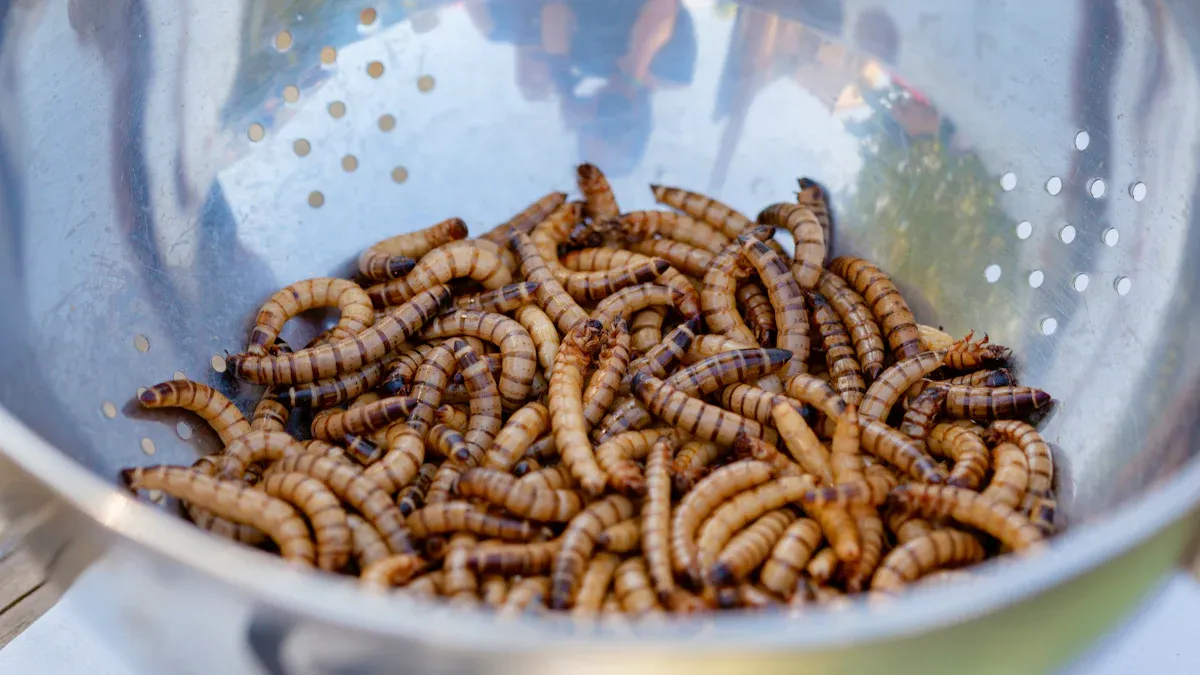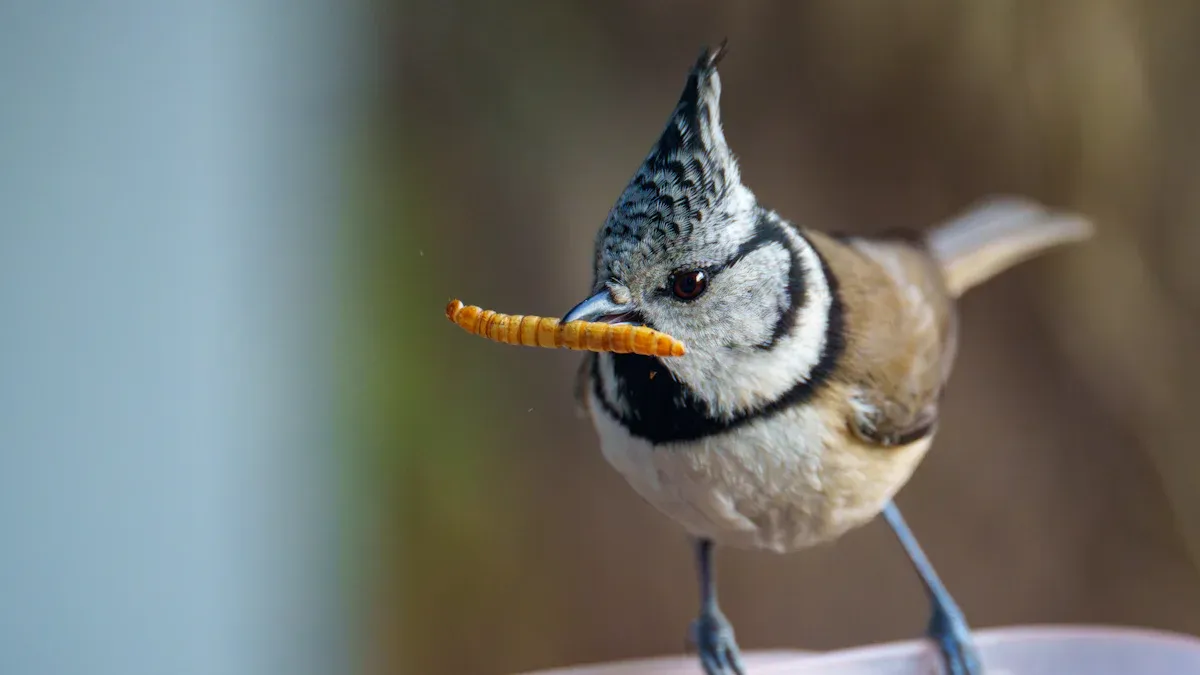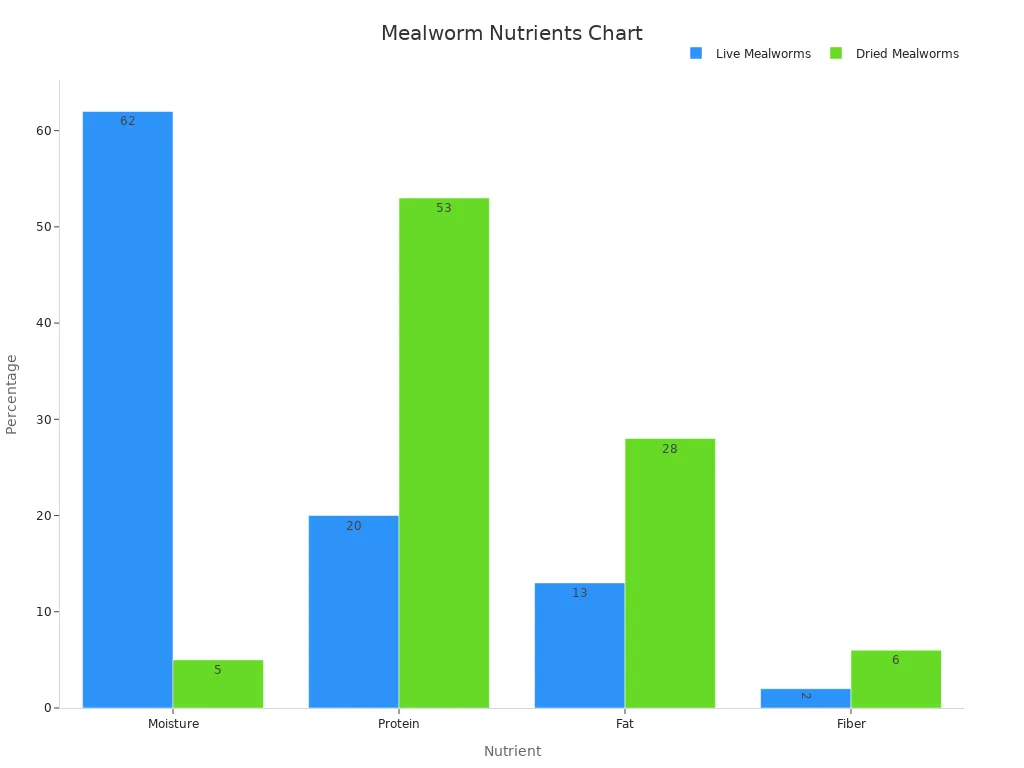
Mealworms for birds serve up a protein-packed feast that keeps robins, bluebirds, and chickadees flocking to feeders. With protein levels reaching up to 68.87% and fat as high as 43.45%, these tasty treats help birds thrive. Even a 1kg bag of dried mealworms can transform an ordinary backyard into a bird hotspot!
Key Takeaways
- Mealworms provide high protein and fat that help birds grow strong and stay energetic, making them a nutritious treat for many backyard birds.
- Offering mealworms during early mornings, nesting season, and cold weather attracts a variety of birds like robins, bluebirds, and chickadees to your yard.
- Dried mealworms store easily and last longer, while live mealworms attract birds with movement; both forms support bird health when fed in proper amounts.
Nutritional Benefits and Bird Species Attracted by Mealworms for Birds

High Protein and Fat Content
Mealworms for birds pack a punch when it comes to nutrition. These tiny treats burst with protein and fat, making them a favorite snack for feathered friends. According to a recent scientific study, mealworm larvae contain about 49.1% protein and 38.3% fat on a dry weight basis. That’s like serving up a superfood buffet for birds! The protein helps birds build strong muscles and feathers, while the fat gives them the energy to zip around the yard. Mealworms also offer a well-balanced amino acid profile, plus important micronutrients like iron, vitamins D, A, E, and zinc. Even humans could benefit from such a nutrient-dense snack, but birds get first dibs in the backyard.
Tip: Dried mealworms, like the ones in our 1kg bag, keep all these nutrients locked in and ready for your garden guests. They also last much longer than live mealworms, so you can treat your birds again and again.
Why Birds Need These Nutrients
Birds lead busy lives. They fly, sing, build nests, and raise chicks. All that activity burns a lot of calories! Protein from mealworms helps birds grow, repair their bodies, and develop strong feathers. Fat acts like a fuel tank, giving birds the energy to survive cold nights and long migrations. Scientific studies show that mealworms provide 20-53% protein and 13-28% lipids, depending on moisture. These nutrients are especially important for young birds, who need easy-to-digest food to grow big and strong.
Mealworms for birds also contain special compounds like chitin and chitosan. Birds can’t make these themselves, but they help boost the immune system and fight off germs. Researchers found that these compounds increase blood globulin levels and help birds resist disease. So, mealworms do more than just fill bellies—they help keep birds healthy and happy.
Common and Less Common Birds That Love Mealworms
Who shows up when you put out mealworms for birds? The list reads like a who’s who of the backyard bird world:
- Robins: These red-breasted charmers can’t resist a mealworm feast.
- Bluebirds: Watch them swoop in for a snack, especially during nesting season.
- Blackbirds: They love dried mealworms and will visit regularly.
- Chickadees: These tiny acrobats snatch up mealworms with lightning speed.
- Wrens: Small but mighty, wrens gobble up mealworms whenever they find them.
- Starlings and Sparrows: These birds often join the party, too.
Some less common visitors might surprise you. Nuthatches, woodpeckers, and even the occasional warbler may stop by for a protein boost. Offering mealworms for birds can turn your backyard into a hotspot for both familiar and rare species.
| Bird Species | Attracted by Mealworms? | Favorite Form |
|---|---|---|
| Robin | ✅ | Dried or Live |
| Bluebird | ✅ | Dried or Live |
| Blackbird | ✅ | Dried |
| Chickadee | ✅ | Dried or Live |
| Wren | ✅ | Dried or Live |
| Nuthatch | ✅ | Dried |
| Woodpecker | ✅ | Dried |
With a 1kg bag of dried mealworms, you can keep all these birds coming back for more. If you’re just starting out, try a 100g or 500g bag for a snack-sized introduction. For yards with lots of hungry birds, the 5kg or 12.55kg bags offer plenty to go around.
How and When to Feed Mealworms for Birds
Best Times to Offer Mealworms
Birds love a good meal at just the right moment. Early mornings and late afternoons bring the most feathered visitors to feeders. During nesting season, parents hustle to find protein-rich snacks for their chicks. Winter chills? Birds need extra energy to stay warm. Mealworms for birds shine brightest during these times. Offer them when the weather turns cold, or when you spot busy parents darting around with beaks full of food. Hungry bluebirds and robins will thank you with cheerful songs and frequent visits.
Serving Methods and Feeder Types
Birds enjoy mealworms in many ways. Some bird lovers use open trays or shallow dishes, making it easy for robins and blackbirds to spot their treats. Others prefer mesh feeders or covered dishes to keep out rain and larger, greedy birds. Place feeders near shrubs or perching spots, but not too close to nestboxes. This keeps predators away and gives shy birds a safe place to snack. For a fun twist, try training birds to come when you whistle or call. Dried mealworms work well in most feeders and stay fresh longer, especially in our handy resealable bags.
Recommended Quantities and Frequency
- Start with small amounts—about 15 mealworms per bird each day.
- Offer mealworms once or twice daily, especially during breeding or cold spells.
- For baby birds, feed tiny portions every 15-20 minutes during daylight hours.
- Watch the birds’ crops and droppings to avoid overfeeding.
- Mix mealworms with other foods for a balanced diet.
Tip: Adjust the amount based on how many birds visit. Hungry flocks may need a bigger bag, like our 1kg dried mealworms, to keep everyone happy!
Live vs. Dried Mealworms for Birds

Bird Preferences and Nutritional Differences
Birds know what they like, and they often pick live mealworms first. In small backyard experiments, bluebirds, wrens, and chickadees raced to grab live mealworms, leaving dried ones for later. The movement of live mealworms catches a bird’s eye, making them look like a tasty bug in the wild. Robins and cardinals sometimes eat all types, but most songbirds show a clear favorite.
Nutritionally, live and dried mealworms have some big differences. Live mealworms burst with moisture, which helps nestlings and young birds stay hydrated. Dried mealworms, on the other hand, pack more protein and fat into every bite. Here’s a quick look at how they compare:
| Nutrient | Live Mealworms (%) | Dried Mealworms (%) |
|---|---|---|
| Moisture | 62 | 5 |
| Protein | 20 | 53 |
| Fat | 13 | 28 |
| Fiber | 2 | 6 |

Mealworms for birds come in both forms, so bird lovers can choose what works best for their feathered visitors.
Storage and Handling Tips
Keeping mealworms fresh and safe is easy with a few simple tricks:
- Blanching mealworms in hot water helps reduce germs and keeps them clean.
- Store dried mealworms in a cool, dry place. Resealable bags work great for this.
- Refrigerate blanched mealworms for up to six days to keep them fresh.
- Freeze mealworms at −20 °C for longer storage and to lock in nutrition.
- Remove mealworms from their bedding a day before feeding to help clean their guts.
- Always check for dead insects or foreign bits before serving.
- Farm-raised mealworms have a low risk of parasites, especially when frozen or cooked.
With these tips, backyard bird feeders can offer safe, nutritious snacks all year round.
Birdwatchers see their yards come alive when they add mealworms.
- Bluebirds, robins, wrens, and woodpeckers swoop in for a snack.
- Mealworms offer protein and energy, especially for young birds.
- Easy to use and store, they boost bird activity and support backyard wildlife health.
Mealworms for birds truly make every feeder a hotspot.
FAQ
Can birds eat dried mealworms every day?
Absolutely! Birds love a daily treat. Dried mealworms provide protein and energy. They keep birds active and healthy. Many backyard birds visit more often for this snack.
How should someone store dried mealworms?
Store dried mealworms in a cool, dry place. Resealable bags work best. No fridge needed! The 1kg bag stays fresh for months, so birds always get tasty treats.
What birds visit feeders for mealworms?
Robins, bluebirds, and blackbirds rush to feeders for mealworms. Chickadees, wrens, and even woodpeckers join the feast. The backyard turns into a bird party every day!


